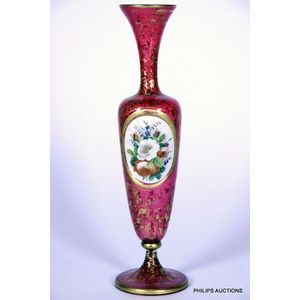Bohemian Enamel Ruby Glass Vase with Floral Decoration
You must be a subscriber, and be logged in to view price and dealer details.
Subscribe Now to view actual auction price for this item
When you subscribe, you have the option of setting the currency in which to display prices to $Au, $US, $NZ or Stg.
- Arabesque - The arabesque pattern is an ornamental design that features flowing, curving lines and elaborate geometric shapes. It is inspired by the art and architecture of the Islamic world and was developed at Fontainebleu France in the mid 16th century. Its use was spread through published engravings, and it is characterized by its intricate and highly decorative nature. The arabesque pattern is created using a repetitive motif that is repeated and interwoven to create a cohesive design. It was used as a form of decoration in art, architecture, textiles, pottery, furniture and ceramics and it is often used to add a sense of grandeur and sophistication to a design. The arabesque pattern is admired for its beauty and complexity, and it continues to be used in a wide range of decorative contexts today.
This item has been included into following indexes:
-
Bohemian (Czech Republic) glass wares
- cups and urns 24
- various wares 461
- vases 238
Visually similar items

An Edwardian period Royal Worcester specimen vase, hand painted with roses in red and yellow to the swollen body, the trumpet neck and decorative base with gilt enrichments, unsigned. Printed marks for 1910 and 'F111/H'. Height 15 cm

Royal Vienna cobalt blue vase, decorated with women

A signed Satsuma bottle vase, Showa period, 1930s-50s, with mark of Koshida, the elegant vase of compressed and carinate form, decorated with flowering pink cherry blossoms framing a pavilion in a landscape scene, with cobalt and gilt bands to the trumpet

A fine Tiffany 'Favrile' trumpet vase, circa 1900, in iridescent gold shot with hot pink and hints of lime, the slender trumpet vase knopped to the lower stem and having a domed and spreading floriform base, etched underside with L.C. Tiffany, Favrile, and
